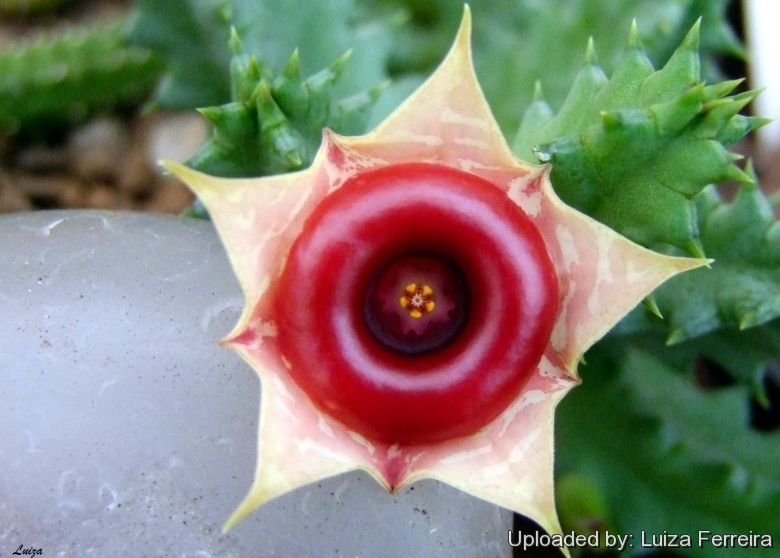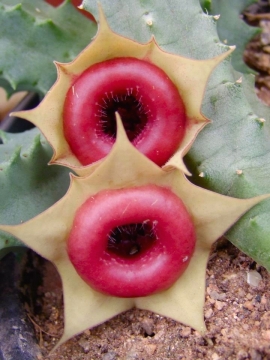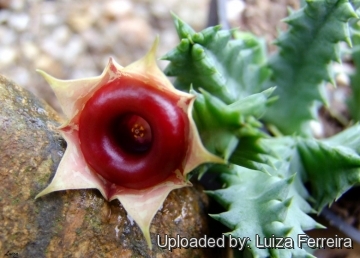
Huernia zebrina subs. insigniflora Photo by: Luiza Ferreira
Origin and Habitat: Limpopo, Northern Province cast of Pietersburg and from Lydenburg to Ohrigstad in Mpumalanga (eastern Transvaal). South Africa.
Altitude range: 1300 - 1850 metres above sea level.
Habitat and ecology: Huernia zebrina subs. insigniflora occurs in rocky situations, but occupies a different habitat, on granite slopes at higher altitudes than the low-veld localities of Huernia zehrina.
Synonyms:
See all synonyms of Huernia zebrina
Description: Huernia zebrinaSN|16032]]SN|21240]] subs. insigniflora (Huernia confusaSN|21240]]SN|21246]]) is a remarkable perennial succulents species with dull greyish-green, 4-angled stems tinged with pink, with acute, spreading teeth. It forms small dense clumps up to 10 cm in diameter. The wide-opening, star-shaped flowers have a distinct, liver-coloured raised ring or annulus at the centre, which looks exactly like a life-belt, and ivory to pink spreading lobes. The corolla lobes are unmarked or, sometimes, faintly mottled or barred and shortly pubescent. Its stems differ from the related Huernia zebrinaSN|21245]]SN|21240]] in being greyish-green with smaller teeth on the angles. Only some authors consider Huernia insignifloraSN|21240]]SN|21245]] to be a good species on its own; the others classify it as a subspecies of Huernia zebrinaSN|21246]]SN|21240]]. Huernia humilisSN|21240]]SN|16032]] in the sense of Schlechter belongs here.
Derivation of speciefic name: The species comes from the Latin 'extraordinary, remarkable' and refers to the striking flowers
Stems: Basally branching, erect, rarely exceeding 3 cm in length grey-green, quadrangular in cross section, 4- (rarely 5-) angular. Angles small, disappearing on older stems.
Inflorescences: Few-flowered, pointing outwards at the base of the stem. Pedicel c. 10 mm long.
Flowers: Opening one at a time in succession. Sepals to 6 mm long. Corolla 2.5 -3.5 cm across, outside light green, in-side greenish-white, ivory-coloured or light yellow, at times pink, tube and the glabrous annulus crimson to dark purple or liver-coloured, tube 7 x 6 mm. Corolla-lobes triangular, shortly pointed, divaricate, lightish yellow to dull gold unmarked or, sometimes, faintly mottled or irregularly transversely streaked with pale rose- pink or purple, outside partly finely roughened, inside puberulous, hairs maroon or streaked with reddish, short, acute, basally sometimes swollen. Outer corona cream-coloured to light yellow, rarely black-purple, some-times with maroon markings, lobes shortly lobed, fused into a disc, margin sometimes with 10 notches. Inner-corona yellowish with dark maroon margin, black or rarely dark maroon, basal hump ivory to orange, lobes acute as long as the Anthers or exceeding them: Poll yellow to dark greenish, elliptic to elongate-elliptic.
Blooming season: Flowering time (in habitat) is November-March.
Subspecies, varieties, forms and cultivars of plants belonging to the Huernia zebrina group
 Huernia zebrina N.E.Br.: has 5-6 angled stems up to 5 cm long, corolla up to 4,5 cm accross. Distribution: Zimbabwe, Mozambique, South Africa (Mpumalanga, KwaZulu-Natal), Swaziland.
Huernia zebrina N.E.Br.: has 5-6 angled stems up to 5 cm long, corolla up to 4,5 cm accross. Distribution: Zimbabwe, Mozambique, South Africa (Mpumalanga, KwaZulu-Natal), Swaziland.  Huernia zebrina subs. insigniflora (C.A.Maass) Bruyns: flowers have liver-coloured or purple annulus, and ivory to pink lobes unmarked or faintly mottled or barred. Stems greyish-green with smaller teeth. Distribution: Limpopo, Mpumalanga.
Huernia zebrina subs. insigniflora (C.A.Maass) Bruyns: flowers have liver-coloured or purple annulus, and ivory to pink lobes unmarked or faintly mottled or barred. Stems greyish-green with smaller teeth. Distribution: Limpopo, Mpumalanga. Huernia zebrina subs. magniflora (E.Phillips) L.C.Leach: has longer, more robust stems, usually 4-angled, corolla up to 8,5 cm accross, variable in size, colour and markings. Distributio: Namibia, Botswana, Zimbabwe, RSA.
Huernia zebrina subs. magniflora (E.Phillips) L.C.Leach: has longer, more robust stems, usually 4-angled, corolla up to 8,5 cm accross, variable in size, colour and markings. Distributio: Namibia, Botswana, Zimbabwe, RSA.
Bibliography: Major refrerences and further lectures
1) Doreen Court “Succulent Flora of Southern Africa” CRC Press, 01 June 2000
2) David Hardy, Anita Fabian, Gerrit Germishuizen “Succulents of the Transvaal” - Page 104
Southern Book Publishers, 1992
3) Focke Albers, Ulrich Meve “Illustrated Handbook of Succulent Plants: Asclepiadaceae: Asclepiadaceae” Volume 4 Springer Science & Business Media, 2002
4) Winter, P.J.D. & Victor, J.E. 2005. “Huernia zebrina N.E.Br. subsp. insigniflora (C.A.Maass) Bruyns.” National Assessment: Red List of South African Plants version 2014.1. Accessed on 2015/02/17
5) Gerrit Germishuizen “Transvaal Wild Flowers” Macmillan South Africa (Publishers), 1982
6) African Succulent Plant Society “The Bulletin of the African Succulent Plant Society, Volumi 9-12” page 78. African Succulent Plant Society., 1974
 Huernia zebrina subs. insigniflora Photo by: Luiza Ferreira
Huernia zebrina subs. insigniflora Photo by: Luiza Ferreira Huernia zebrina subs. insigniflora Photo by: Luiza Ferreira
Huernia zebrina subs. insigniflora Photo by: Luiza Ferreira Huernia zebrina subs. insigniflora Photo by: Luiza Ferreira
Huernia zebrina subs. insigniflora Photo by: Luiza Ferreira Huernia zebrina subs. insigniflora Photo by: Luiza Ferreira
Huernia zebrina subs. insigniflora Photo by: Luiza Ferreira Huernia zebrina subs. insigniflora Photo by: Luiza Ferreira
Huernia zebrina subs. insigniflora Photo by: Luiza FerreiraSend a photo of this plant.The gallery now contains thousands of pictures, however it is possible to do even more. We are, of course, seeking photos of species not yet shown in the gallery but not only that, we are also looking for better pictures than those already present.
Read More... Cultivation and Propagation: Huernia zebrinaSN|21240]]SN|21240]] subs. insigniflora isn't difficult to grow and flower. Both subspecies require a very draining substrate with a big portion of sharp sand or perlite or pumice. They need winter temperature over 10 °C and they need very careful watering during warm days. As with other stapeliads, the most dangerous diseases and pests are black rot and mealy bugs. The easiest way of propagation is by rooting stem cuttings or by sowing, if seeds are available. Half shade in Summer.















